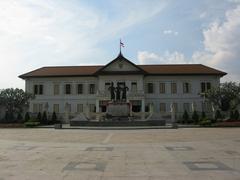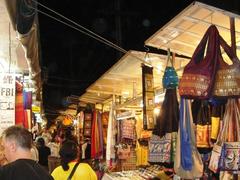Wat Phra That Doi Kham: Visiting Hours, Tickets, and Historical Sites in Chiang Mai
Date: 17/07/2024
Introduction
Table of Contents
- Introduction
- Early Beginnings and the Legend of the Golden Relic
- Expansion and Royal Patronage
- Architectural Splendor and Symbolic Representations
- Visiting Hours and Ticket Prices
- Travel Tips and Nearby Attractions
- Wat Phra That Doi Kham Today: A Place of Pilgrimage and Tranquility
- The Significance of Doi Kham Mountain
- Cultural Insights and Etiquette
- Conclusion
- FAQ
Wat Phra That Doi Kham: Visiting Hours, Tickets, and Historical Significance
Early Beginnings and the Legend of the Golden Relic
The temple’s origins date back to the 7th century during the reign of Queen Jamadevi, the first ruler of the Hariphunchai Kingdom. Legend has it that two hunter brothers discovered a glowing crystal relic, believed to be a piece of Buddha’s shoulder bone, inside a cave on the mountain. This discovery led to the construction of a chedi (stupa) to enshrine the sacred relic, marking the beginnings of Wat Phra That Doi Kham.
Expansion and Royal Patronage
During the 15th century, under the reign of King Muang Kaeo of the Lanna Kingdom, the temple underwent significant renovations and expansions. A larger chedi was constructed to house the venerated relic, solidifying the temple’s importance as a religious center. The temple’s strategic location on Doi Kham mountain, offering panoramic views of the surrounding valleys, also contributed to its significance.
Architectural Splendor and Symbolic Representations
The Giant Naga Stairway and Guardian Deities
A striking feature of Wat Phra That Doi Kham is the grand staircase guarded by two imposing Naga serpents. These mythical creatures, often depicted as protectors of sacred sites in Buddhist mythology, flank the stairway leading up to the main temple area. Their intricate scales and fierce expressions serve as a reminder of the temple’s sanctity and the spiritual journey undertaken by those who ascend to its heights.
The Reclining Buddha Image and Spiritual Significance
Within the temple grounds, visitors encounter a serene reclining Buddha image, a representation of the Buddha during his final moments before entering Nirvana. This image, often depicted with a peaceful expression and surrounded by offerings, serves as a reminder of the impermanence of life and the importance of seeking enlightenment.
Visiting Hours and Ticket Prices
Wat Phra That Doi Kham is open daily from 6:00 AM to 6:00 PM. There is no entrance fee to visit the temple, but donations are welcome to help with its maintenance and upkeep. Visitors are encouraged to dress modestly and respect the temple’s sacred atmosphere.
Travel Tips and Nearby Attractions
How to Get There
The temple is located about 10 kilometers southwest of Chiang Mai city center. Visitors can reach the temple by car, taxi, or songthaew (a shared red truck). The drive offers scenic views of the surrounding countryside.
Best Time to Visit
Early morning or late afternoon is the best time to visit to avoid the midday heat and enjoy the serene atmosphere.
Nearby Attractions
- Royal Park Rajapruek: A beautiful botanical garden showcasing a variety of plant species and themed gardens.
- Chiang Mai Night Safari: A unique zoo offering night-time safari tours to see nocturnal animals in their natural habitats.
- Wat Phra That Doi Suthep: Another significant temple located on a nearby mountain.
Wat Phra That Doi Kham Today: A Place of Pilgrimage and Tranquility
Today, Wat Phra That Doi Kham remains an active place of worship and pilgrimage for Thai Buddhists, particularly during significant religious festivals. Devotees gather to pay their respects to the enshrined relic, offer prayers, and participate in traditional ceremonies. The temple’s serene atmosphere, surrounded by lush greenery and offering breathtaking views, also attracts visitors seeking respite from the bustling city below.
The Significance of Doi Kham Mountain
Beyond its religious significance, Doi Kham mountain holds cultural and historical importance for the people of Chiang Mai. The mountain’s name, translating to ‘Golden Mountain,’ reflects the belief that it possesses a hidden vein of gold. This belief, passed down through generations, adds to the mystique and allure of both the mountain and the temple that graces its summit.
Cultural Insights and Etiquette
Visiting Wat Phra That Doi Kham offers a glimpse into the rich cultural tapestry of Thailand and the profound influence of Buddhism on Thai society. To ensure a respectful and meaningful experience, it’s essential to observe proper temple etiquette.
- Dress Code: When visiting temples in Thailand, it’s crucial to dress modestly, covering shoulders and knees. Avoid wearing revealing clothing such as shorts, sleeveless tops, or tight-fitting attire. It’s advisable to carry a sarong or shawl to drape over your clothing if needed.
- Respectful Behavior: Maintain a respectful demeanor within the temple grounds. Remove your shoes before entering any temple building. Avoid talking loudly or engaging in disruptive behavior. Refrain from pointing your feet at Buddha images or monks.
- Photography: While photography is generally permitted in temple courtyards, it’s essential to be mindful of sacred spaces. Avoid using flash photography inside temple buildings, as it can be disruptive and disrespectful. Always ask for permission before photographing monks or worshippers.
- Offerings: Making merit by offering donations to the temple is a common practice in Thailand. These offerings, often in the form of money, incense, candles, or flowers, support the temple’s upkeep and contribute to the well-being of the monks.
- Interaction with Monks: Monks are highly respected figures in Thai society. When interacting with them, it’s customary to wai (a traditional Thai greeting with hands pressed together in prayer position) and avoid making direct eye contact. Women should never touch a monk or his robes.
Conclusion
FAQ
Q: What are the visiting hours for Wat Phra That Doi Kham?
A: The temple is open daily from 6:00 AM to 6:00 PM.
Q: Is there an entrance fee for Wat Phra That Doi Kham?
A: There is no entrance fee, but donations are appreciated.
Q: How can I get to Wat Phra That Doi Kham?
A: The temple is about 10 kilometers southwest of Chiang Mai city center and can be reached by car, taxi, or songthaew.
Q: What are some nearby attractions to Wat Phra That Doi Kham?
A: Nearby attractions include the Royal Park Rajapruek, Chiang Mai Night Safari, and Wat Phra That Doi Suthep.

